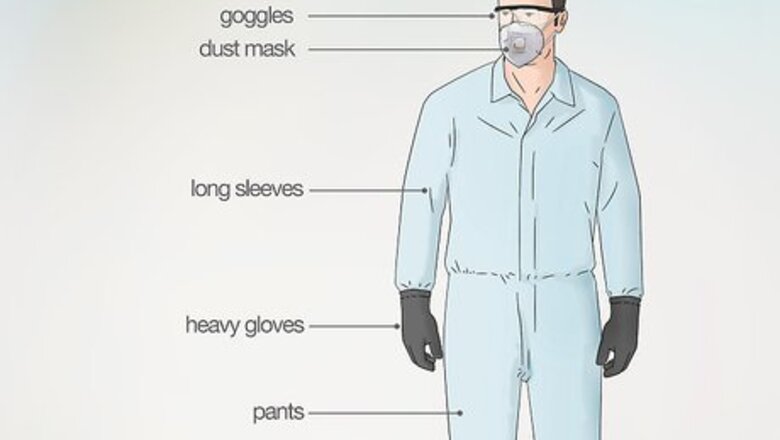
views
- Sand your car with 40-grit sandpaper starting with the large, flat surfaces. Wipe the car with a moist rag and repeat with 120, 220, and then 400-grit paper.
- Or, sand your car with 80-grit paper, brush on automotive paint stripper, and cover your car in plastic for 15 minutes. Then, scrape the paint off with a putty knife.
- Rinse and dry your car after removing the paint, then prime it immediately to prevent rust.
Sanding Single Layers
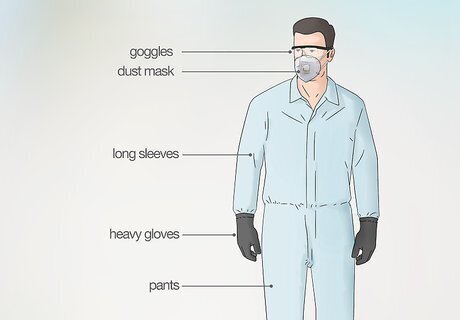
Put on goggles, a dust mask, heavy gloves, long sleeves and pants. Electric sanding throws a lot of dust and debris into the air. Protect your face with goggles and a dust mask or respirator. Wear heavy work gloves to avoid getting cut. Also cover all your exposed skin with your clothes so no debris gets stuck in your skin. Work in a well-ventilated area. Outside is best. If you’re in a garage, keep the door open. Spread a sheet under the car to catch any falling debris.

Load a dual-action sander with 40-grit sandpaper. A dual-action sander uses compressed air to spin the sanding surface. Start with a coarse, 40-grit sandpaper. This strips off the top layer of paint. You can buy or rent sanders from a hardware store. You can also use a grinder. This strips the paint off much faster. However, it can also damage the metal. Always keep the grinder moving and don’t hover over one spot to avoid denting the bare metal. Another option is sanding by hand, without an electric sander. This is extremely time-consuming, but you will save money. Also, sanding by hand is a better option if you own a classic car to avoid damaging the body. Use a sanding block at the same grit levels as you use for the electric sander.

Begin sanding on large, flat surfaces like the hood. Flat surfaces like the hood or roof are the easiest to sand, so start here. Start the sander and press it down on the car surface with even pressure. Leaning the sander to one side could cause denting. Slide the sander slowly across the car and let it grind off the paint as you move. If the car has only been painted once, you’ll see the white primer and then bare metal. If there are multiple paint layers, spend more time on each section to strip it away. Some spots may be tougher than others. If the paint won’t come off in one spot, keep the sander there for a few seconds to work the paint off. Replace the sandpaper when it gets too dull. You’ll notice that it doesn’t strip the paint as well after a while. This means it’s time for a new piece of paper.
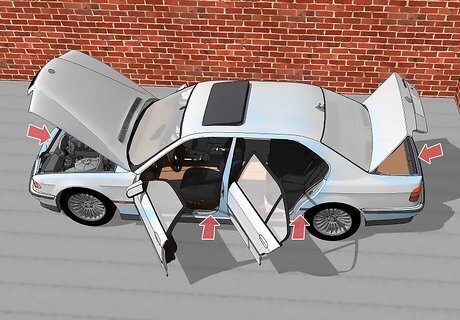
Open the doors, hood, and trunk to access tighter areas. Once you've tackled the larger areas, move on to tight areas like the ones around the doors. These are tougher to reach, so try opening doors and the trunk to get into tight spots. Angle your sander so it fits into these areas. Spread a sheet inside your car to protect the interior from dust and debris. If there are tight areas at angles you can't reach, try using a sand block on these spots instead.
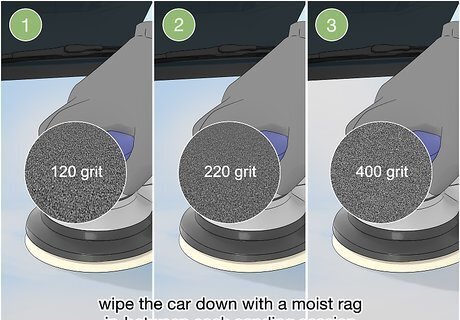
Sand again with 120, 220, and 400-grit paper. After finishing with the 40-grit paper, wipe the car down with a moist rag to remove any dust. Then load finer-grit paper onto the sander. Do another sanding round with 120, 220, and 400-grit paper. Remember to wipe the car down in-between each sanding session. This process removes small sections of oxidation and rust that you can’t see with the naked eye. Leaving these on the car’s surface could damage a new paint layer over time.

Wash your car when you’re done sanding to remove remaining dust. Once you’ve gone through all the sanding steps and the car is down to its bare metal, give the car a good wash. Use water and soap to remove any dirt and debris. Then let the car dry completely. For a faster job, you can also wipe the car down with mineral spirits rather than wash it with soap and water. Once all the paint is off and the car is clean, continue with painting the car. If you’re going to paint the car, apply primer as soon as the car is dry to prevent rusting.
Chemical Stripping Multiple Layers

Park the car on top of a plastic sheet. Stripping paint with chemicals is messy. Avoid making a mess in your driveway or garage by spreading out a large plastic sheet. Then park the car on top of it. Don’t use a sheet that you want to use again. The chemicals and paint remnants will ruin it. Paint stripper produces fumes, so work outside or in a garage with the door open.
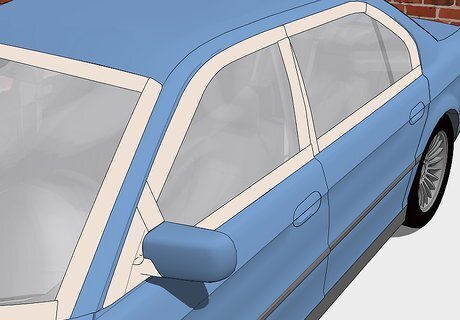
Cover all the parts on the car that you don’t want paint stripper on. Paint stripper can damage rubber and glass, so don’t let it get on anything besides the paint. First, spread painting tape on all the trim areas of the car. Also cover any openings in the hood and between the doors. Then use plastic sheets to cover the windshield and windows. If you’re not stripping paint from the whole car, then cover painted areas as well.
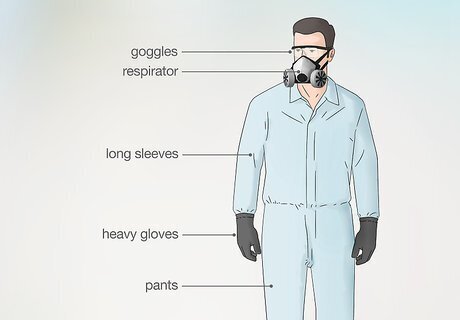
Put on a respirator, thick gloves, goggles, and thick clothes. Sanding paint produces irritating dust and paint stripper is a corrosive, toxic chemical. Protect yourself throughout the whole process by covering all your exposed skin before sanding or handling the chemicals. Wear long sleeves, pants, and thick work gloves. Then protect your face with goggles and a respirator. If you get any paint stripper on your skin, run the area under cold water for 5 minutes. If you get any in your eye or mouth, contact poison control right away.
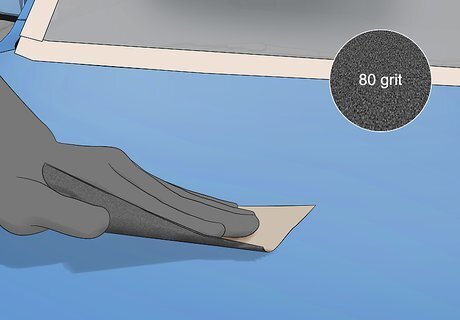
Sand the paint lightly with 80-grit sandpaper to prepare it for the chemicals. Do a preliminary sanding with a medium-grit sandpaper. Use a dual-action sander to make the job go faster, or do it by hand. Sand all the areas that you’ll be pouring chemicals on. Don’t try to strip off all the paint with this sanding. It only has to disturb the surface so the chemicals can soak in better.
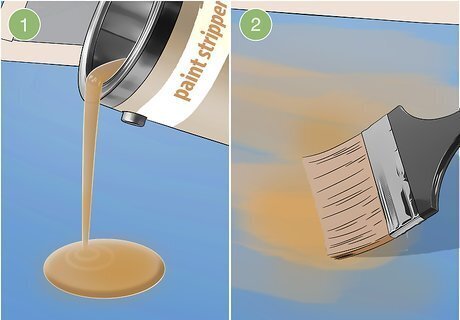
Pour automotive paint stripper onto the car and spread it with a brush. Start by pouring the chemical onto the surface you’re stripping. It is a thick, syrupy substance, so it spreads slowly. Then use a paint brush and spread it around. Cover all the areas that you want to remove paint from. Automotive paint stripper is available at hardware and auto stores. If you can’t find the right product, ask an employee for assistance. Check the surface area that 1 container of the stripper will cover. Get more if this isn’t enough to cover your car. Always read the instructions on the product before using it. Follow those directions if they differ from the ones given here.
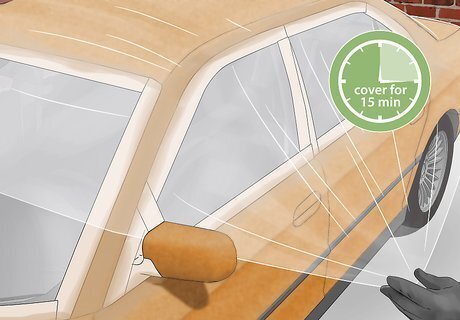
Cover the paint stripper with plastic and let it sit for 15 minutes. The plastic contains fumes and accelerates the paint stripping process. Lay the plastic out and press it against the paint stripper. Then let the mixture sit covered for 15 minutes. You don’t have to tape the plastic down. It sticks to the paint stripper. If the product label tells you to let the paint stripper sit for a different amount of time, follow those instructions.
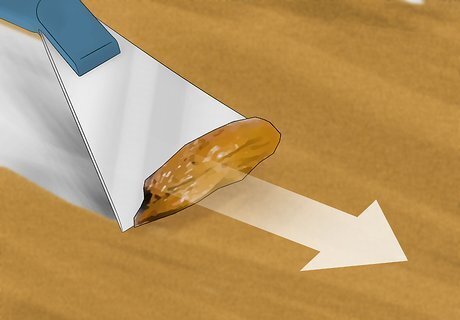
Scrape the paint off with a putty knife. Peel the plastic off after 15 minutes. Most of the paint will turn into a gel-like substance by this time. Take a putty knife and scrape all the paint off the car’s surface. Most will come off easily. Just push the stripped paint off and onto the floor. This is what the plastic sheet was for. Some spots might require a bit more scraping. Rub back and forth a few times if any paint is still stuck. Put all the plastic sheets in a garbage bag and seal it. Contact your local trash collection agency to check if you should place in the regular trash or save it for a hazardous waste pickup. They will likely ask you the main ingredients, so have the packaging nearby to check.
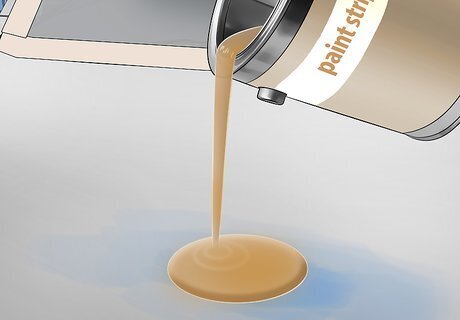
Pour more paint stripper on paint that’s still stuck. If your car has multiple layers of paint, some might not come off after the first chemical application. After you scrape off all the loose paint, check the car for remaining spots. Rub some more paint stripper on it, cover it with plastic, wait 15 minutes, and scrape again. Repeat this for any spots that still have paint on them.
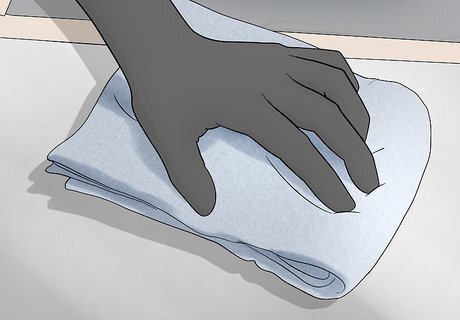
Wipe the remaining chemicals off with a wet rag. Use a rag with no soap or solvents. Then scrub all the areas you poured paint stripper on. Rinse and re-wet the rag as it soaks up chemicals. If needed, use a fresh rag when the one you’re using gets too dirty. After you wipe all the chemicals and paint residue off, remove the tape and plastic from the car. Don’t use any solvent or other chemicals to wipe off the paint stripper. Mixing other chemicals could produce toxic fumes.
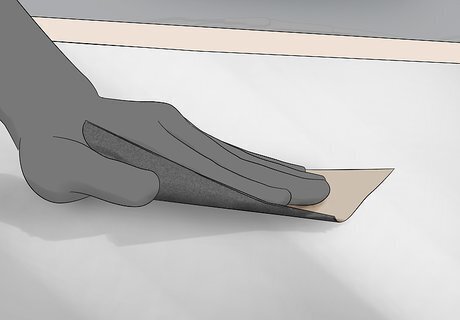
Sand the metal to prepare it for priming and painting. Finally, remove any remaining rust and paint with a thorough sanding. Start with a coarse, 40-grit paper. Then work up to using a 120, 220, and 400-grit paper. Wipe down the metal with mineral spirits after each sanding session. Use a dual-action sander to make this job much easier. However, you can sand by hand if you don’t have a sander.
















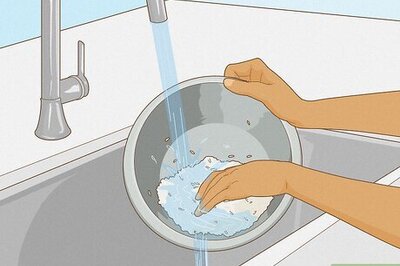
Comments
0 comment